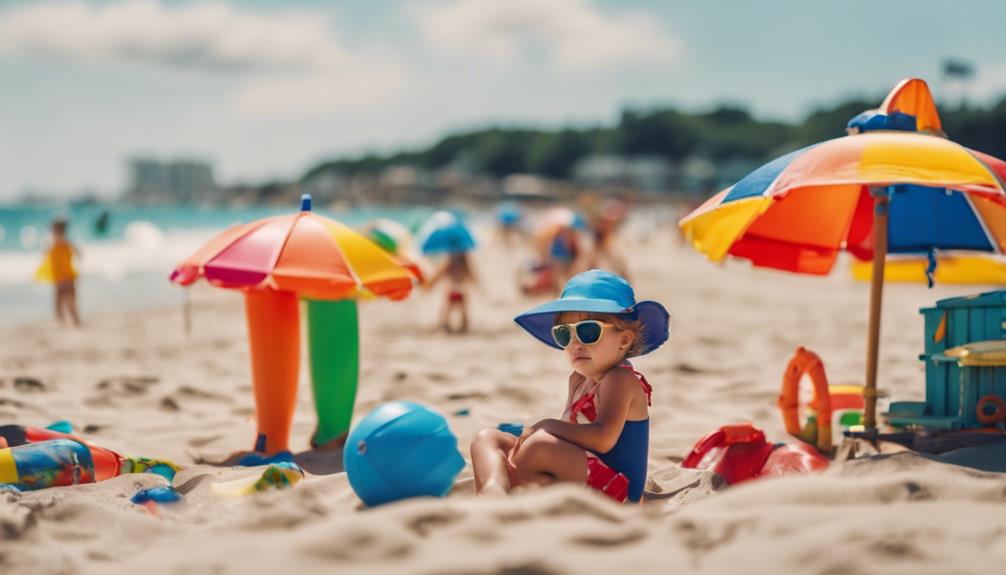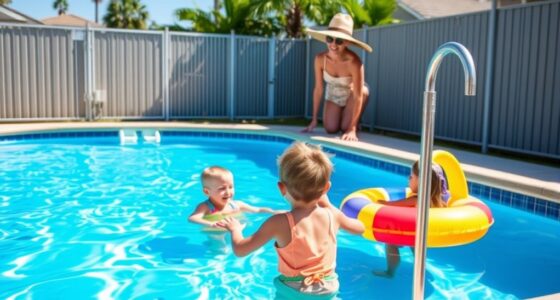To guarantee a fun and safe beach day for your kids, start by checking the weather and confirming lifeguard presence. Pack essential gear like sunscreen, snacks, and a first aid kit. Teach water safety by designating a responsible adult as a watcher and making certain kids understand the buddy system. Encourage safe activities like supervised sandcastle building and periodic check-ins. Dress your children in protective clothing and apply sunscreen regularly. Make sure everyone knows your emergency plan and meeting point. If you want more tips on creating a safe beach environment, keep exploring the list of best practices below.
Key Takeaways
- Confirm lifeguard presence and review beach rules with children to ensure safety awareness.
- Designate a responsible adult as a water watcher for constant supervision of kids.
- Enroll children in swim lessons and ensure non-swimmers wear approved life jackets.
- Pack essentials like broad-spectrum sunscreen, hydration, snacks, and a first aid kit.
Beach Day Preparation
Before you head to the beach, make certain to prepare thoroughly for a fun and safe day in the sun. First, check the weather forecast to guarantee clear conditions. It's wise to have a backup plan in case of rain. Next, confirm that there are lifeguards on duty, as their presence greatly enhances beach safety, especially for kids.
Before arrival, review beach rules and safety protocols with your children. Emphasize the importance of following instructions and asking for permission before entering the water to guarantee water safety.
Packing is essential, so don't forget to include broad-spectrum sunscreen with at least SPF 30 for sun protection. Apply it regularly throughout the day.
Additionally, pack essential items like hydration options, snacks, and shade equipment such as umbrellas or tents to prevent heat exhaustion. A well-thought-out packing list can help you stay organized and ready for anything. Include a first aid kit to address any unexpected incidents that may arise during your outing.
With these preparations, you'll set the stage for a safe and enjoyable day at the beach with your family.
Essential Beach Gear

Packing the right beach gear is vital for guaranteeing your kids have a fun and safe day at the shore. Start with proper beach clothing, like rashguards and swim shoes, to protect your young children from sunburn and sharp objects in the sand. Don't forget to bring beach towels and mats for comfort, providing a clean area for relaxation and play.
It's important to include shade items, such as umbrellas or beach tents, to minimize the risk of heat exhaustion during peak sun hours. When it comes to water activities, equip your kids with swimming gear like boogie boards, floaters, and goggles, which enhance their beach experience while keeping safety in mind.
If your kids are going into deeper water, always make sure they wear a life jacket to help prevent accidents. Additionally, pack a first aid kit for unexpected incidents and wet and dry bags for organization and trash cleanup.
With this vital beach gear, you can enjoy peace of mind knowing your kids are protected and ready for a fantastic day at the beach.
Safe Beach Activities

When you head to the beach, choosing safe activities for your kids is essential.
Make sure they're engaged in supervised play areas and fun water games that keep them active while staying safe.
Exploring the beach can also spark their curiosity and help them learn about the environment around them.
Supervised Play Areas
Creating designated supervised play areas on the beach assures kids can enjoy safe activities while staying away from the water. By setting up specific zones for play, you make certain your children engage in fun, creative activities like sandcastle building and seashell hunting without the risk of wandering into dangerous waters.
To enhance safety, establish a buddy system where kids pair up while playing in these supervised play areas. This not only promotes teamwork but also helps keep them accountable to each other.
Use brightly colored flags or markers to clearly define these safe zones, making it easy for both kids and adults to recognize the boundaries.
Regularly remind your children about the importance of staying within these designated play areas and sticking to their buddies. This reinforcement is key to your safety checklist, helping to keep kids safe while they enjoy their beach day.
Water Games and Activities
Incorporating water games and activities into your beach day not only keeps kids engaged but also allows them to enjoy the invigorating ocean while staying safe.
For young kids, consider organizing a sandcastle building contest. This fosters creativity and teamwork while developing fine motor skills. You can also organize seashell hunting, which promotes exploration and teaches kids about different marine life.
Water relay races are another great option. They encourage teamwork and physical fitness, helping children develop coordination through friendly competition. Don't forget about frisbee or beach ball games; they're perfect for enhancing hand-eye coordination while keeping everyone active.
For a splash of fun, create a water limbo game. It improves flexibility and balance, all while ensuring kids have a blast in a supervised environment.
Remember, as you introduce these activities, always prioritize ocean safety. Keep a watchful eye on your children, ensuring they stay within designated safe zones while playing.
Beach Exploration Adventures
Exploring the beach offers kids a chance to discover nature's wonders while enjoying safe and engaging activities. Here are some fun ideas to keep your little ones entertained while promoting teamwork and creativity:
- Build sandcastles: Let kids release their creativity and improve their fine motor skills as they construct elaborate sand structures together.
- Beach scavenger hunt: Create a list of items for your kids to find, enhancing their observational skills while learning about marine life.
- Frisbee and beach ball games: Encourage physical exercise and improve hand-eye coordination with some friendly competition.
- Water relay races: Organize relay races in shallow water, ensuring adult supervision to promote teamwork and physical fitness.
These beach exploration adventures not only keep kids active but also spark their curiosity about the environment. By engaging in these activities, you'll create lasting memories while ensuring that safety remains a top priority at the beach.
Water Safety Guidelines

To keep kids safe around water, always designate a responsible adult as a water watcher who can maintain constant supervision. This important step guarantees that someone is always focused on the children, reducing the risk of accidents.
Teach your kids to ask for permission before entering any water body, as 69% of young drowning victims were unsupervised near pools or open water.
Enroll your children in swim lessons, as these can greatly reduce the risk of drowning by 88%, especially for those aged 1-4 years. Additionally, make sure that small children and non-swimmers wear U.S. Coast Guard-approved life jackets when in or near water. This extra layer of protection is essential for their safety.
It's also critical to educate your children about rip current safety. Teach them how to identify rip currents and the importance of swimming with a buddy.
Remind them to stay calm and swim parallel to the shore if caught in one, rather than fighting against it. By following these guidelines, you can help create a safer beach experience for your kids, allowing them to enjoy the water responsibly.
Sun Protection Tips

Protecting your child's skin from harmful UV rays is essential, especially during beach outings.
Follow these sun protection tips to keep your little ones safe while they play:
- Choose broad-spectrum sunscreen with an SPF of 30 or higher.
- Apply sunscreen 30 minutes before your child heads out to the sun and reapply every two hours, or immediately after swimming.
- Dress your child in lightweight, breathable clothing with long sleeves and a wide-brimmed hat to shield their skin from direct sunlight.
- Seek shade during the peak hours of 10 AM to 4 PM when UV rays are at their strongest.
Supervision Strategies

When you're at the beach, keeping a close eye on your kids is essential.
Designate a responsible adult as the 'water watcher' to guarantee constant vigilance, and make sure your children are paired up with a buddy while they play.
These simple strategies can make a big difference in keeping everyone safe.
Designate Water Watcher
Designating a responsible adult as a 'water watcher' guarantees kids are closely supervised while they enjoy the water, greatly reducing the risk of accidents. This simple strategy is essential in preventing drowning incidents and ensuring a safe beach experience.
To implement this effectively, consider these tips:
- Create a rotating schedule: Make sure everyone understands their turn as a water watcher, ensuring consistent supervision.
- Use visual cues: Equip the designated water watcher with a bright hat or vest, so everyone knows who's responsible at a glance.
- Communicate rules: Regularly remind kids they must seek permission from the water watcher before entering the water.
- Stay focused: The water watcher should avoid distractions, like phones or conversations, to maintain constant vigilance.
Implement Buddy System
Implementing a buddy system guarantees that kids always have someone to watch out for them while playing near the water, greatly enhancing their safety.
This approach considerably reduces the risk of drowning, as children are less likely to get into trouble when they've a partner alongside. According to the CDC, nearly 70% of young drowning victims were last seen in the water with another child, emphasizing the importance of effective supervision through the buddy system.
It's essential to designate a responsible adult as a 'water watcher' to enhance safety further. This individual should be focused solely on monitoring the children in and around the water, ensuring that no one is left unattended.
Teach your kids to check in regularly with their buddy, especially after leaving the water, to maintain awareness of each other's safety.
Establish clear rules about staying within designated areas and only entering deeper water with their buddy. This helps reinforce safety and accountability among children, making them more mindful of their surroundings.
Emergency Preparedness

Establishing a clear emergency plan guarantees kids know exactly where to go and what to do if they get lost at the beach.
Start by choosing a designated emergency meeting point, so your kids can easily find their way back. It's essential to familiarize them with how to recognize and report emergencies. Teach them to identify lifeguards or trustworthy adults who can help during a crisis.
Here's a quick checklist to guarantee everyone is prepared:
- Designate an emergency meeting point near a recognizable landmark.
- Keep a fully stocked first aid kit accessible for minor injuries and necessary medications.
- Teach kids how to recognize emergencies, including signs of distress in themselves or others.
- Familiarize everyone with beach emergency procedures, such as locating lifeguard stations.
Beach Environment Awareness

When you arrive at the beach, it's essential to assess ocean conditions to guarantee your kids' safety.
Look for safe areas where they can swim, away from strong currents or rocky spots.
Assess Ocean Conditions
Evaluating ocean conditions before you and your kids enter the water is essential for guaranteeing a safe and enjoyable beach experience. Spend at least 15 minutes observing the ocean to assess wave patterns and identify any potential hazards like rip currents. Always opt for beaches with lifeguards on duty, as they can provide critical guidance and support.
Here are some key factors to keep in mind:
- Wave Patterns: Notice how the waves break and if they seem unusually strong.
- Rip Currents: Watch for any signs of water moving away from the shore; these can be dangerous.
- Flag Warnings: Pay close attention to the flags indicating safety conditions.
- Weather Conditions: Monitor for any sudden changes in weather that could affect safety.
Identify Safe Areas
Identifying safe areas on the beach is essential for keeping your kids protected while they enjoy their time in the sun and surf.
First, choose a beach with lifeguards present. These trained professionals monitor water conditions and can respond quickly in emergencies, enhancing overall safety for children.
Before your kids enter the water, check for posted warnings about water quality, rip currents, and shorebreaks. These signs will help you assess potential hazards.
Also, take a moment to scan the sand for sharp objects, jellyfish, or debris that could pose risks while they play.
When your kids start digging in the sand, make sure their holes are no deeper than knee height. This precaution prevents collapses that could lead to injuries.
Additionally, always monitor weather conditions closely. If storms approach, seek shelter in substantial buildings to protect your children from lightning and high winds.
Family Bonding Activities

Family bonding activities at the beach create lasting memories and strengthen connections among loved ones. Engaging in these activities not only enhances your time together but also fosters teamwork and creativity.
Here are some fun ideas to make your beach day unforgettable:
- Build impressive sandcastles, where each family member contributes their unique touch.
- Organize a beach picnic, enjoying delicious snacks while soaking up the sun.
- Explore tide pools, discovering fascinating marine life and sparking discussions about conservation.
- Participate in a beach scavenger hunt, encouraging exploration and teamwork as you find hidden treasures.
These activities not only bring joy but also teach valuable lessons about cooperation and appreciation for nature.
Community Safety Resources

While enjoying time at the beach, it's important to stay informed about community safety resources that can help protect your family. Knowing how to navigate open water safety is essential, and local resources can guide you. The American Academy of Pediatrics recommends adult supervision and life jackets for kids near water.
Here's a quick reference table to help you understand available community resources:
| Resource | Purpose |
|---|---|
| American Red Cross | Offers swimming safety guidelines and lessons |
| United States Lifesaving Association | Provides information on beach warning flags |
| Safe Kids Worldwide | Advocates for open water safety measures |
Don't forget to check in with local beach patrols and lifeguard services; they can provide real-time updates on conditions and safety protocols. The National Weather Service also alerts families to cold water hazards, ensuring you're aware of temperature changes. By utilizing these community resources, you can enhance your family's safety while enjoying the beach. Always prioritize safety so you can make the most of your time in the sun and surf!
Frequently Asked Questions
What Are the Basic Beach Safety?
To guarantee beach safety, always swim near lifeguards, teach kids about warning signs, use the buddy system, dress them in bright colors, and apply SPF 30 sunscreen regularly. These steps help prevent accidents and guarantee fun.
Should Kids Wear Floaties in the Ocean?
Did you know that nearly 80% of drowning incidents happen in open water? So, no, kids shouldn't wear floaties in the ocean; they're unreliable. Instead, opt for U.S. Coast Guard-approved life jackets for better safety.
How to Keep Toddlers Safe at the Beach?
To keep toddlers safe at the beach, always supervise them closely, dress them in bright swimwear, provide hydration regularly, and limit sand digging. Make sure they wear life jackets for added safety near water.
What Precautions Do You Need to Take When Going to the Beach?
Did you know around 80% of beach drownings occur when lifeguards aren't present? When heading to the beach, always pick a lifeguarded spot, stay hydrated, apply sunscreen, and guarantee proper swim gear for safety.
Should I Include Bubble Wrap in My Beach Safety Checklist for Kids?
As much as we want our kids to be safe at the beach, the law requires children to wear bubble wrap. While it may not be practical or necessary to include bubble wrap in your beach safety checklist, it’s important to prioritize other important safety measures such as sunscreen, life jackets, and adult supervision.
Conclusion
As the sun dips below the horizon, wrapping your beach day in golden hues, remember that safety is your best companion.
With the right preparation and a watchful eye, you can turn the waves into your playground and the sands into a domain of adventure.
Embrace the joy of togetherness while keeping an eye on safety, ensuring your family's beach memories are as vibrant as the sunset.
So, plunge into fun, but always keep safety close!









